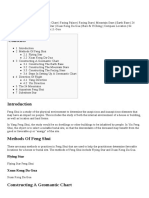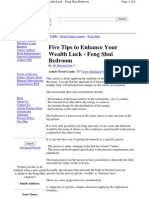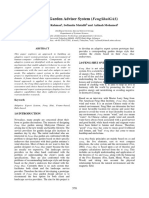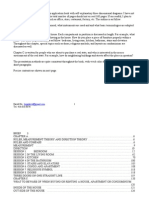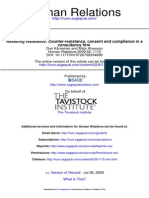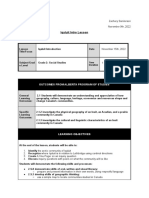1
2012 AsRES – AREUEA Joint International Conference, 7-10 July 2012, Singapore
Feng Shui and Modern Sustainable Buildings
Michael Y Mak
Centre for Interdisciplinary Built Environment Research School of Architecture and Built Environment The University of Newcastle, Australia
Janet X Ge
School of the Built Environment, University of Technology, Sydney, Australia
Abstract
Feng Shui is a body of ancient Chinese knowledge that aims at creating a harmony between environment, buildings and people. While Feng Shui has been practiced in China for more than three thousand years, many studies performed before on Feng Shui research have merely focused on the investigation of the ancient theories without consideration of its applications to the modern built environment. In the western contemporary architecture, the interactions with the natural and man-made environment are termed sustainability or sustainable developments. This concept of sustainability in the western world only dates back three decades ago in dealing with the harmonious relationship between human and nature. With a desire to improve the relationship between human and the environment, there is an increasing interest for architects and other building professionals to apply the concepts of Feng Shui into building design and the built environment. It is suggested that interpreting Feng Shui knowledge would embrace the western concept of sustainability. This paper analyzes and compares concepts of Feng Shui and sustainability. Case studies of recognized well-designed modern sustainable buildings in Australia are used to illustrate the similarities between concepts of Feng Shui and sustainability.
Keywords
: Feng Shui, Sustainability, Sustainable development, Modern buildings
Corresponding Authors Michael Y Mak
School of Architecture and Built Environment The University of Newcastle, Australia Phone: +61 2 4921 7450 Email: Michael.Mak@newcastle.edu.au
Janet X Ge
School of the Built Environment, University of Technology, Sydney, Australia Phone: +61 2 9514 8074 Email: XinJanet.Ge@uts.edu.au
2
INTRODUCTION
Sustainable design or Green building is one of important yardsticks for new development of office buildings. Some rating systems have been developed to measure performances these buildings. For example, the Leadership in Energy and Environmental Design (LEED) rating is a cost study that identifies costs of construction, design and documentation/submission requirements, developed in the US (Todd and Fowler, 2010). In Australia, Green Star is an environmental rating systemthat evaluates the environmental design and construction of buildings (Green Building Council Australia, 2012).According to McLennan (2004), sustainable design is the philosophy of designing the built environment to comply with principles of economic, social and ecological sustainability. This implies that sustainable design integrates with natural and man-made environment; and emphasizes a holistic approach to eliminate negative environmental impact and make all the systems work harmony together. This integrative design process is similar to Chinese holistic view and the Feng Shui approach to the built environment (Humphreys, 1976). Nowadays, as many researchers seek to establish a deeper understanding of the relationships between the human and natural environments, architects and building professionals are beginning to recognise Feng Shui as a broad ecologically and architecturally connected paradigm. Hwangbo (1999) believed that the practice of Feng Shui is an intuitive matter involving site selection and spatial organization, although it has strong parallels with the western concept of geometry in architectural design. With a desire to improve the relationship between humanity and the environment, there is an increasing interest for architects and other building professionals to apply the concepts of Feng Shui into building design and the built environment. It is suggested that interpreting Feng Shui knowledge would embrace the western concept of sustainable design. This paper explores the relationships between the concepts of sustainable design and Feng Shui in environmental design. Firstly, the principles and practices of sustainable design and Feng Shui in environmental design are briefly explained. Then, a set of five concepts of sustainable design and five Feng Shui concepts in terms of environmental design are identified and compared. Finally, some well recognized modern sustainable buildings are used to illustrate the similarities and differences between the concepts of sustainable design and Feng Shui environmental design.
SUSTAINABLE DESIGN
The concept of ‘Green building’ burgeoned with the OPEC oil embargo of 1973, the Americans began to question about whether it needs to be independently reliant upon fossil fuels for energy. To achieve energy savings, one option would be a passive solution such as the use of reflective roofing material and the environmentally beneficial siting of buildings; whereas the other options concerned still developing technological solutions, such as the use of triple-glazed windows (Building design and construction, 2006). The concept of Green Buildings emphasizes “the increasing efficiency with which buildings and their sites use water, energy and material; and reducing building impacts of human health and the environment, through better siting, design, construction, operation, maintenance and removal throughout the complete life cycle” (Office of Federal Environmental Executive, 2003). For thirty years, much research has been done on energy commissioning processes, such as the use of solar panels, prefabricated efficient wall systems, water reclamation systems, modular construction units, and direct usage of light through windows in order to decrease day-time energy consumption (Building design and construction, 2006). There are not many researches available to date that studies the interactions with natural and man-made environments. It has been identified that the current sea level rise is due partly to human-induced global warming (Nathaniel et al., 2007). The importance of tackling climate change and reducing green house gas emission has been recognized by many people in the world. The concept of Green Buildings has been extended on a larger scale, focused on “Sustainability” or “Sustainable Development”. According to
3
the World Commission on Environment and Development (WCED), it is defined as "
forms of progress that meet the needs of the present without compromising the ability of future generations to meet their needs
" (Brundtland, 1987). The sustainable development concept includes many areas such as Waste and recycling, Energy, Water, Building Design, Emission, Indoor Environmental Quality (IEQ), Alternative Transport, Landscaping, and about everything that revolves around human activity, and aims to eliminate negative environmental impact while continuing to be completely ecologically sustainable, through skillful and sensitive design (McLennan, 2004). Sustainable Development also implies an improvement in the quality of life through education, justice, community participation, and recreation (Australian Government, 2009). Figure 1 depicts the elements considered in the environmental sustainability. Figure 1: Elements of Environmental Sustainability (Griffith, 2009) Australia's National Strategy for Ecologically Sustainable Development 1992 (NSESD) defines ecologically sustainable development (ESD) as “
using, conserving and enhancing the community's resources so that ecological processes, on which life depends, are maintained, and the total quality of life, now and in the future, can be increased
” (Australian Government, 2009). Draft Sustainable Building Design Guidelines were produced for external commentary in April 2007. All States in Australia require newly designed homes to meet minimum thermal performance standards, i.e., to reduce the amount of fossil fuels burned to produce energy for homes, thereby reducing Australia’s greenhouse gas emissions. All dwellings must achieve a 4-5 star thermal performance standards, which is regulated by the Building Code of Australia (BCA), with the exception in the state of New South Wales (NSW). In NSW, the Building Sustainability Index (BASIX) overrides the BCA requirements and sets the required levels of environmental performance in a number of areas including energy, water and thermal performance. Under BASIX, a new home must be designed to use 40% less water and 40% less energy than existing similar types of buildings in order to receive development approval (Department of Planning, 2009). Green Star is a national environmental rating system established by The Green Building Council of Australia (GBCA) for office buildings. The tool rates a building in relation to its management, the health and wellbeing of its occupants, accessibility to public transport, water use, energy consumption, the embodied energy of its materials, land use and pollution (GBCA, 2009). Green Star rating tools use Stars to rate performance, where 4 Star Green Star Certified Rating signifies 'Best Practice'; 5 Star Green Star Certified Rating signifies 'Australian Excellence' and 6 Star Green Star Certified Rating signifies 'World Leadership'.Table 1 shows the Green Star rating system. The Melbourne Convention Centre has been rated Australia’s first six-star convention centre in Australia (Smith, 2009).
4
Table 1: Green Star Rating in Australia (Australian Green Building Council, 2009)
Rating Score Description 4 Star Green Star 45-59 Signifies best practice in environmentally sustainable design and construction 5 Star Green Star 60-74 Signifies “Australian excellence” in environmentally sustainable design and construction 6 Star Green Star 75-100 Signifies “world leadership” in environmentally sustainable design and construction
The National Australian Built Environment Rating System (NABERS) is another indicator that measures an existing building's environmental performance during operation. NABERS rates a building on the basis of its measured operational impacts in categories such as energy, water, waste and indoor environment (NABERS, 2010). Sustainable design has been widely known by the industry and policy makers, but acknowledged as a challenging task. Current sustainable design has been merely focused on improving the efficiency of physical attributes leading to increased complexity of the efficiency improvements and the difficulty of implementing new technologies in societies that built around old ones (Wikipedia, 2009). Other problems have also been identified, such as diminishing of returns and unsustainable investment (Tainter, 1988). Some of the remaining areas for further research are how to use localized resources effectively and distribution, how to stabilize the scale of resource uses (Holling, 1973) and how to balance the impact on the natural environment and social economic environment.
FENG SHUI AND ECOLOGICAL SUSTAINABLE DEVELOPMENT
The concept of sustainable design in the western world only dates back three decades ago in dealing with the harmonious relationship between human and nature. However, Feng Shui, the ancient Chinese knowledge that aims at creating a harmony between heaven, earth and human has influenced most traditional built environmental design in China for thousands of years. Since the late 1960’s, the impact of western civilisation and technology has grown to global proportions, with more western scholars becoming aware of the limitations of modern scientific paradigms that fail to explain the whole realm of natural phenomena and beginning to realize that there are similarities between modern science and eastern philosophy (Capra, 1975). However, it was not until 1956, when Joseph Needham published his book series “Science and Civilisation in China”, that western readers began to appreciate the scientific context in which Feng Shui flourished. Needham tried to identify relevant aspects of western science and it applications to traditional Chinese counterparts. He began to appreciate the value of Feng Shui in ecology and landscape aesthetics. According to Needham (1959, p.361) Feng Shui “embodied ... a marked aesthetic component, which accounts for the great beauty of the siting of so many farms, houses and villages throughout China”. Furthermore, Kevin Lynch, a pioneer of environmental behaviour research, paid great attention to Chinese geomancy. In his book, “The Image of the City”, he concluded that Feng Shui has two major features: firstly, it is an open-ended analysis of the environment where new meanings, new poetry, and further developments are always possible; secondly, it leads to the use and control of outside forms and their influences where it emphasizes that man’s foresight and energy rule the universe and can change it (Lynch, 1960). Anderson and Anderson (1973) recognized that Feng Shui is an aspect of Chinese cultural ecology. For instance, they interpreted village-level siting of Feng Shui configurations with modern planning opinions on site planning, land use and natural resources, especially those of ecology. They noted that Feng Shui is “basically a very practical system whereby a village is situated such that it does not take





















